Quality Practice Strategies: A Community-Based Fall Prevention Program
VerifiedAdded on 2023/01/12
|10
|2371
|85
Report
AI Summary
This report analyzes quality practice strategies for a community-based fall prevention program, aligning with the Australian National Safety and Quality Health Service Standards. It emphasizes establishing a culture of quality, identifying improvement areas, data analysis, and effective communication. The report details the impact of falls on the elderly, discussing risk factors like age, medication, and impaired vision, and outlines clinical practice strategies including falls risk screening and assessment. It highlights the importance of clinical communication, identifies key risk factors such as mobility and balance deficits, and proposes risk management and injury prevention strategies like balance training, mobility training, and the use of hip protectors. The report underscores the need for collaboration among healthcare professionals to deliver comprehensive fall prevention services. The assignment aims to increase the understanding of the 10 national safety and quality health service standards and how these are implemented.
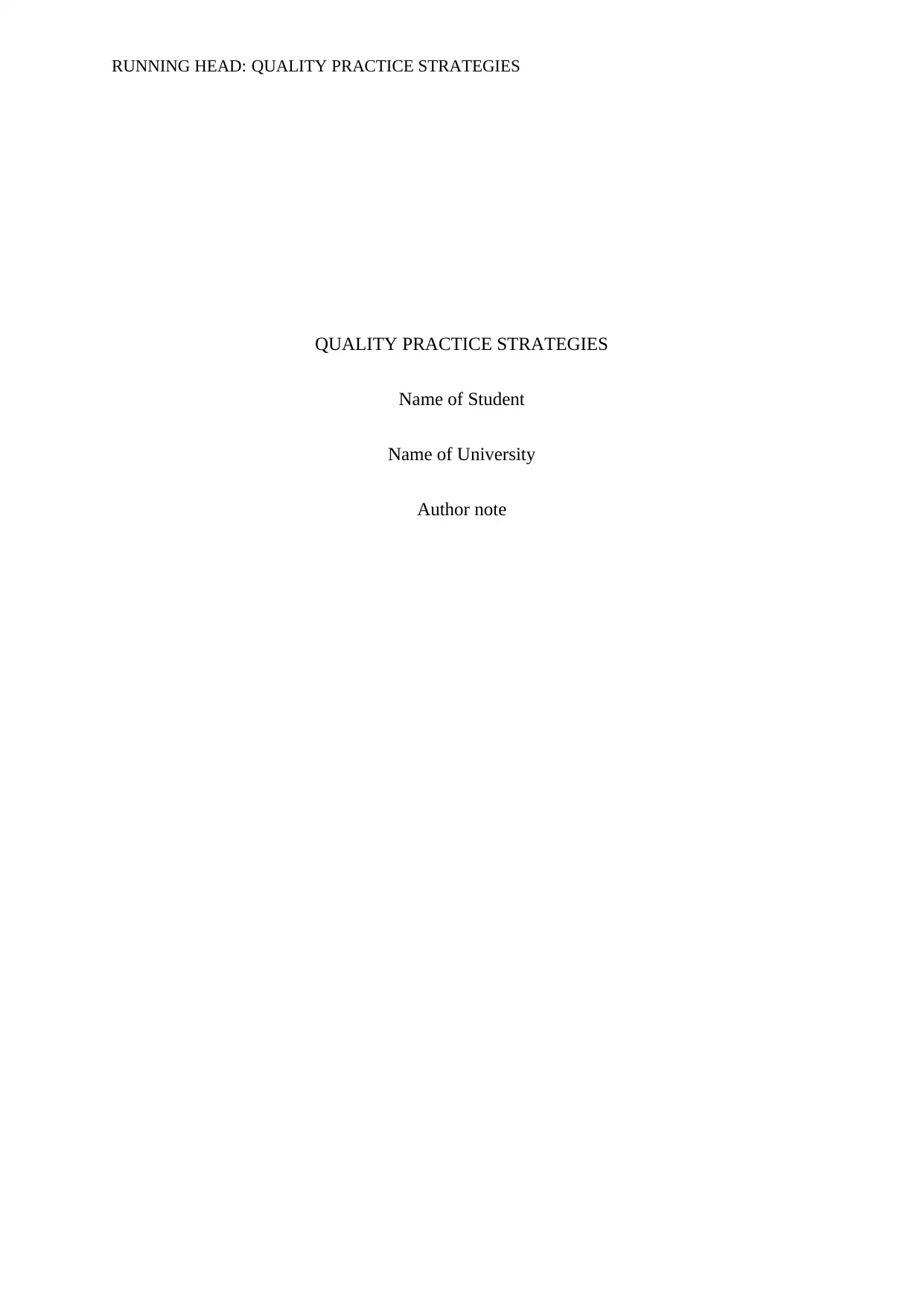
RUNNING HEAD: QUALITY PRACTICE STRATEGIES
QUALITY PRACTICE STRATEGIES
Name of Student
Name of University
Author note
QUALITY PRACTICE STRATEGIES
Name of Student
Name of University
Author note
Paraphrase This Document
Need a fresh take? Get an instant paraphrase of this document with our AI Paraphraser
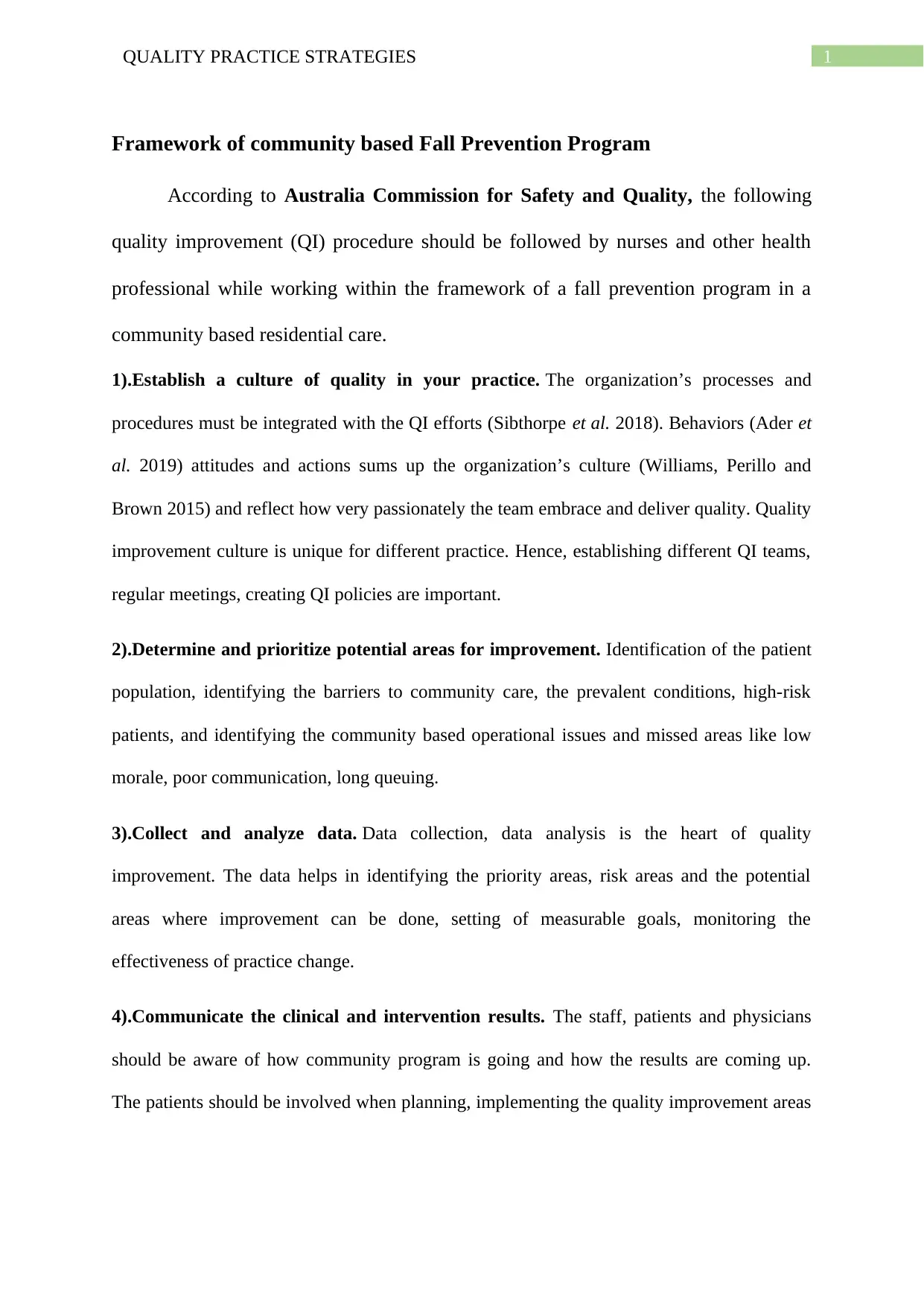
1QUALITY PRACTICE STRATEGIES
Framework of community based Fall Prevention Program
According to Australia Commission for Safety and Quality, the following
quality improvement (QI) procedure should be followed by nurses and other health
professional while working within the framework of a fall prevention program in a
community based residential care.
1).Establish a culture of quality in your practice. The organization’s processes and
procedures must be integrated with the QI efforts (Sibthorpe et al. 2018). Behaviors (Ader et
al. 2019) attitudes and actions sums up the organization’s culture (Williams, Perillo and
Brown 2015) and reflect how very passionately the team embrace and deliver quality. Quality
improvement culture is unique for different practice. Hence, establishing different QI teams,
regular meetings, creating QI policies are important.
2).Determine and prioritize potential areas for improvement. Identification of the patient
population, identifying the barriers to community care, the prevalent conditions, high-risk
patients, and identifying the community based operational issues and missed areas like low
morale, poor communication, long queuing.
3).Collect and analyze data. Data collection, data analysis is the heart of quality
improvement. The data helps in identifying the priority areas, risk areas and the potential
areas where improvement can be done, setting of measurable goals, monitoring the
effectiveness of practice change.
4).Communicate the clinical and intervention results. The staff, patients and physicians
should be aware of how community program is going and how the results are coming up.
The patients should be involved when planning, implementing the quality improvement areas
Framework of community based Fall Prevention Program
According to Australia Commission for Safety and Quality, the following
quality improvement (QI) procedure should be followed by nurses and other health
professional while working within the framework of a fall prevention program in a
community based residential care.
1).Establish a culture of quality in your practice. The organization’s processes and
procedures must be integrated with the QI efforts (Sibthorpe et al. 2018). Behaviors (Ader et
al. 2019) attitudes and actions sums up the organization’s culture (Williams, Perillo and
Brown 2015) and reflect how very passionately the team embrace and deliver quality. Quality
improvement culture is unique for different practice. Hence, establishing different QI teams,
regular meetings, creating QI policies are important.
2).Determine and prioritize potential areas for improvement. Identification of the patient
population, identifying the barriers to community care, the prevalent conditions, high-risk
patients, and identifying the community based operational issues and missed areas like low
morale, poor communication, long queuing.
3).Collect and analyze data. Data collection, data analysis is the heart of quality
improvement. The data helps in identifying the priority areas, risk areas and the potential
areas where improvement can be done, setting of measurable goals, monitoring the
effectiveness of practice change.
4).Communicate the clinical and intervention results. The staff, patients and physicians
should be aware of how community program is going and how the results are coming up.
The patients should be involved when planning, implementing the quality improvement areas
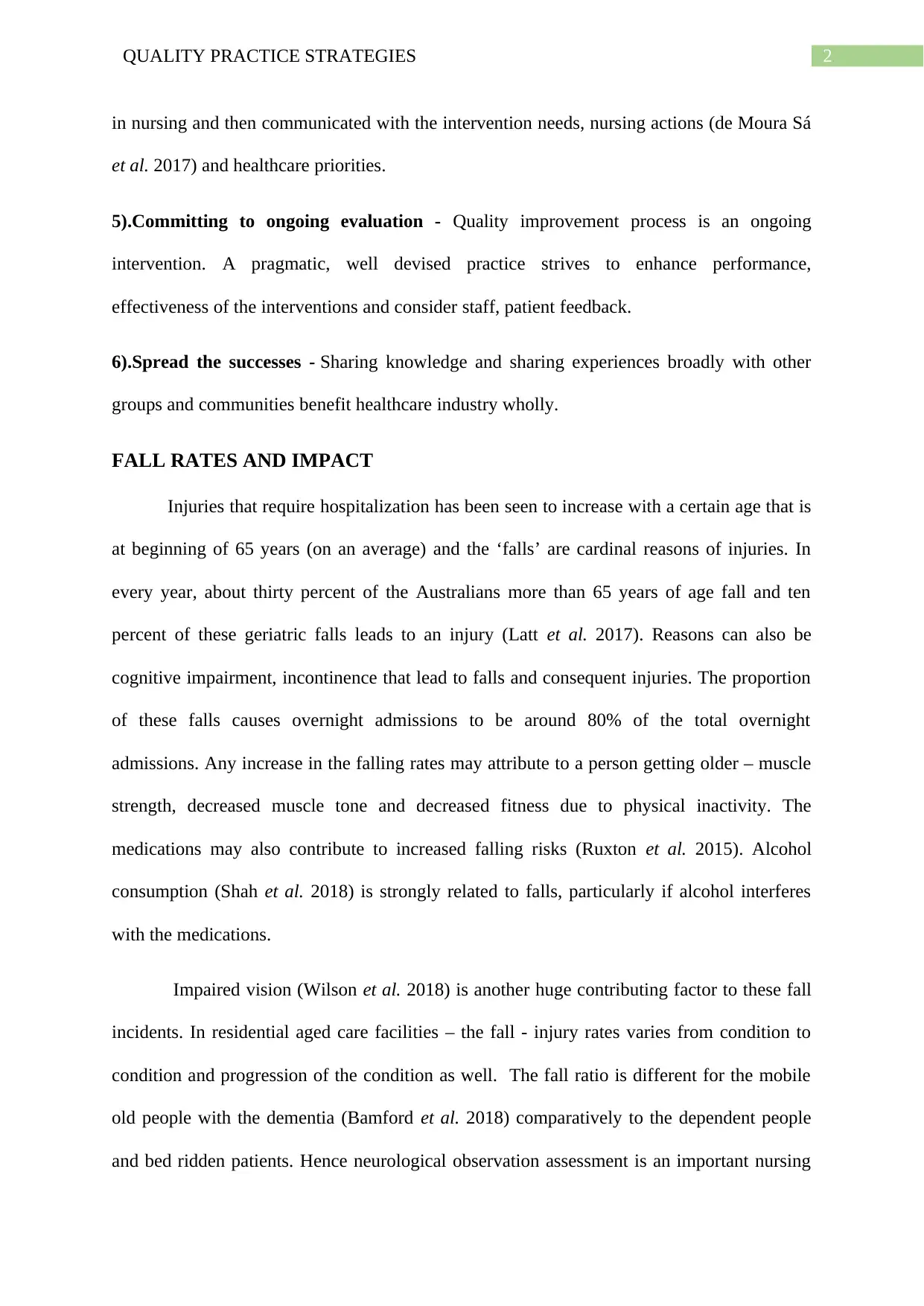
2QUALITY PRACTICE STRATEGIES
in nursing and then communicated with the intervention needs, nursing actions (de Moura Sá
et al. 2017) and healthcare priorities.
5).Committing to ongoing evaluation - Quality improvement process is an ongoing
intervention. A pragmatic, well devised practice strives to enhance performance,
effectiveness of the interventions and consider staff, patient feedback.
6).Spread the successes - Sharing knowledge and sharing experiences broadly with other
groups and communities benefit healthcare industry wholly.
FALL RATES AND IMPACT
Injuries that require hospitalization has been seen to increase with a certain age that is
at beginning of 65 years (on an average) and the ‘falls’ are cardinal reasons of injuries. In
every year, about thirty percent of the Australians more than 65 years of age fall and ten
percent of these geriatric falls leads to an injury (Latt et al. 2017). Reasons can also be
cognitive impairment, incontinence that lead to falls and consequent injuries. The proportion
of these falls causes overnight admissions to be around 80% of the total overnight
admissions. Any increase in the falling rates may attribute to a person getting older – muscle
strength, decreased muscle tone and decreased fitness due to physical inactivity. The
medications may also contribute to increased falling risks (Ruxton et al. 2015). Alcohol
consumption (Shah et al. 2018) is strongly related to falls, particularly if alcohol interferes
with the medications.
Impaired vision (Wilson et al. 2018) is another huge contributing factor to these fall
incidents. In residential aged care facilities – the fall - injury rates varies from condition to
condition and progression of the condition as well. The fall ratio is different for the mobile
old people with the dementia (Bamford et al. 2018) comparatively to the dependent people
and bed ridden patients. Hence neurological observation assessment is an important nursing
in nursing and then communicated with the intervention needs, nursing actions (de Moura Sá
et al. 2017) and healthcare priorities.
5).Committing to ongoing evaluation - Quality improvement process is an ongoing
intervention. A pragmatic, well devised practice strives to enhance performance,
effectiveness of the interventions and consider staff, patient feedback.
6).Spread the successes - Sharing knowledge and sharing experiences broadly with other
groups and communities benefit healthcare industry wholly.
FALL RATES AND IMPACT
Injuries that require hospitalization has been seen to increase with a certain age that is
at beginning of 65 years (on an average) and the ‘falls’ are cardinal reasons of injuries. In
every year, about thirty percent of the Australians more than 65 years of age fall and ten
percent of these geriatric falls leads to an injury (Latt et al. 2017). Reasons can also be
cognitive impairment, incontinence that lead to falls and consequent injuries. The proportion
of these falls causes overnight admissions to be around 80% of the total overnight
admissions. Any increase in the falling rates may attribute to a person getting older – muscle
strength, decreased muscle tone and decreased fitness due to physical inactivity. The
medications may also contribute to increased falling risks (Ruxton et al. 2015). Alcohol
consumption (Shah et al. 2018) is strongly related to falls, particularly if alcohol interferes
with the medications.
Impaired vision (Wilson et al. 2018) is another huge contributing factor to these fall
incidents. In residential aged care facilities – the fall - injury rates varies from condition to
condition and progression of the condition as well. The fall ratio is different for the mobile
old people with the dementia (Bamford et al. 2018) comparatively to the dependent people
and bed ridden patients. Hence neurological observation assessment is an important nursing
⊘ This is a preview!⊘
Do you want full access?
Subscribe today to unlock all pages.

Trusted by 1+ million students worldwide
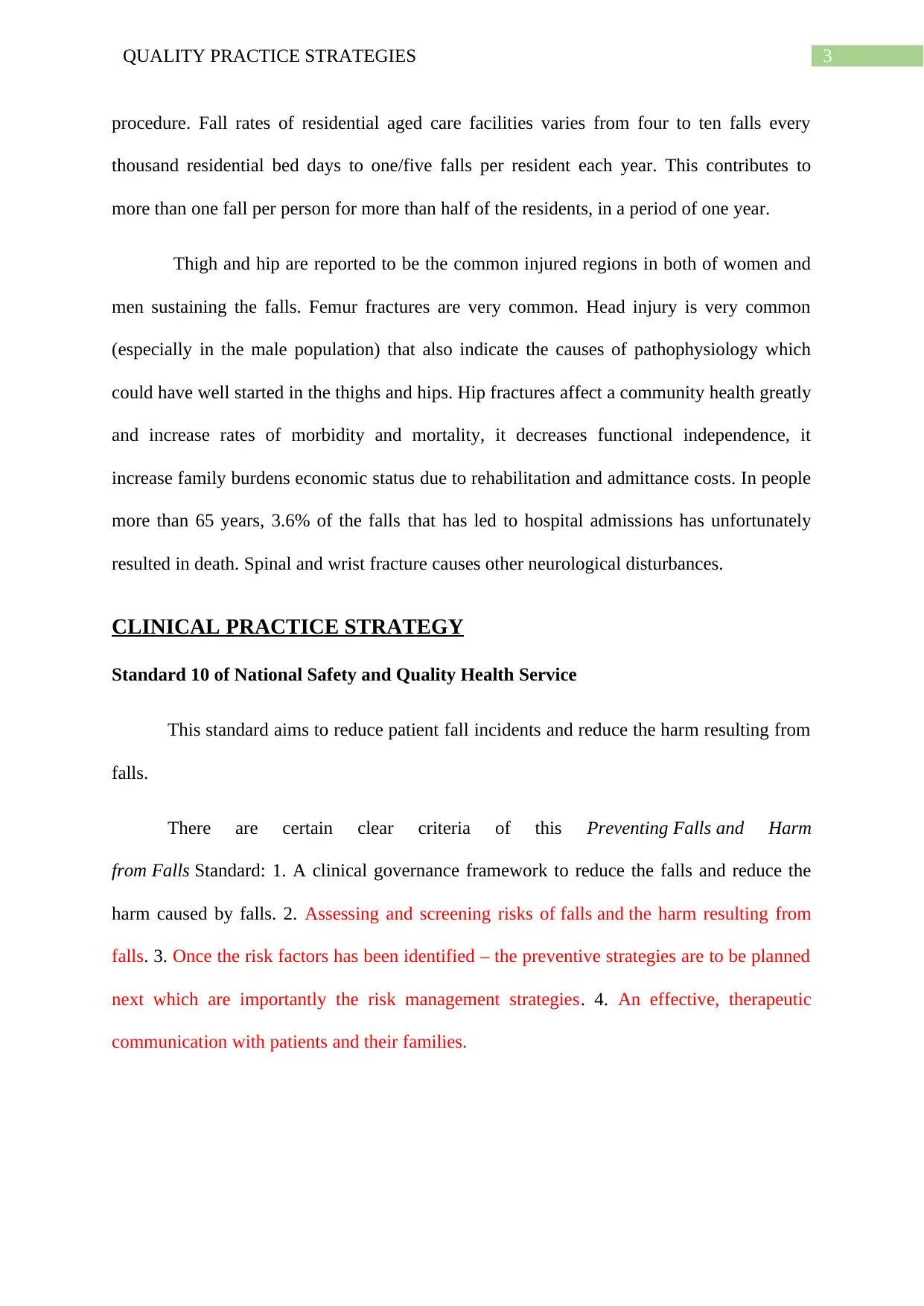
3QUALITY PRACTICE STRATEGIES
procedure. Fall rates of residential aged care facilities varies from four to ten falls every
thousand residential bed days to one/five falls per resident each year. This contributes to
more than one fall per person for more than half of the residents, in a period of one year.
Thigh and hip are reported to be the common injured regions in both of women and
men sustaining the falls. Femur fractures are very common. Head injury is very common
(especially in the male population) that also indicate the causes of pathophysiology which
could have well started in the thighs and hips. Hip fractures affect a community health greatly
and increase rates of morbidity and mortality, it decreases functional independence, it
increase family burdens economic status due to rehabilitation and admittance costs. In people
more than 65 years, 3.6% of the falls that has led to hospital admissions has unfortunately
resulted in death. Spinal and wrist fracture causes other neurological disturbances.
CLINICAL PRACTICE STRATEGY
Standard 10 of National Safety and Quality Health Service
This standard aims to reduce patient fall incidents and reduce the harm resulting from
falls.
There are certain clear criteria of this Preventing Falls and Harm
from Falls Standard: 1. A clinical governance framework to reduce the falls and reduce the
harm caused by falls. 2. Assessing and screening risks of falls and the harm resulting from
falls. 3. Once the risk factors has been identified – the preventive strategies are to be planned
next which are importantly the risk management strategies. 4. An effective, therapeutic
communication with patients and their families.
procedure. Fall rates of residential aged care facilities varies from four to ten falls every
thousand residential bed days to one/five falls per resident each year. This contributes to
more than one fall per person for more than half of the residents, in a period of one year.
Thigh and hip are reported to be the common injured regions in both of women and
men sustaining the falls. Femur fractures are very common. Head injury is very common
(especially in the male population) that also indicate the causes of pathophysiology which
could have well started in the thighs and hips. Hip fractures affect a community health greatly
and increase rates of morbidity and mortality, it decreases functional independence, it
increase family burdens economic status due to rehabilitation and admittance costs. In people
more than 65 years, 3.6% of the falls that has led to hospital admissions has unfortunately
resulted in death. Spinal and wrist fracture causes other neurological disturbances.
CLINICAL PRACTICE STRATEGY
Standard 10 of National Safety and Quality Health Service
This standard aims to reduce patient fall incidents and reduce the harm resulting from
falls.
There are certain clear criteria of this Preventing Falls and Harm
from Falls Standard: 1. A clinical governance framework to reduce the falls and reduce the
harm caused by falls. 2. Assessing and screening risks of falls and the harm resulting from
falls. 3. Once the risk factors has been identified – the preventive strategies are to be planned
next which are importantly the risk management strategies. 4. An effective, therapeutic
communication with patients and their families.
Paraphrase This Document
Need a fresh take? Get an instant paraphrase of this document with our AI Paraphraser
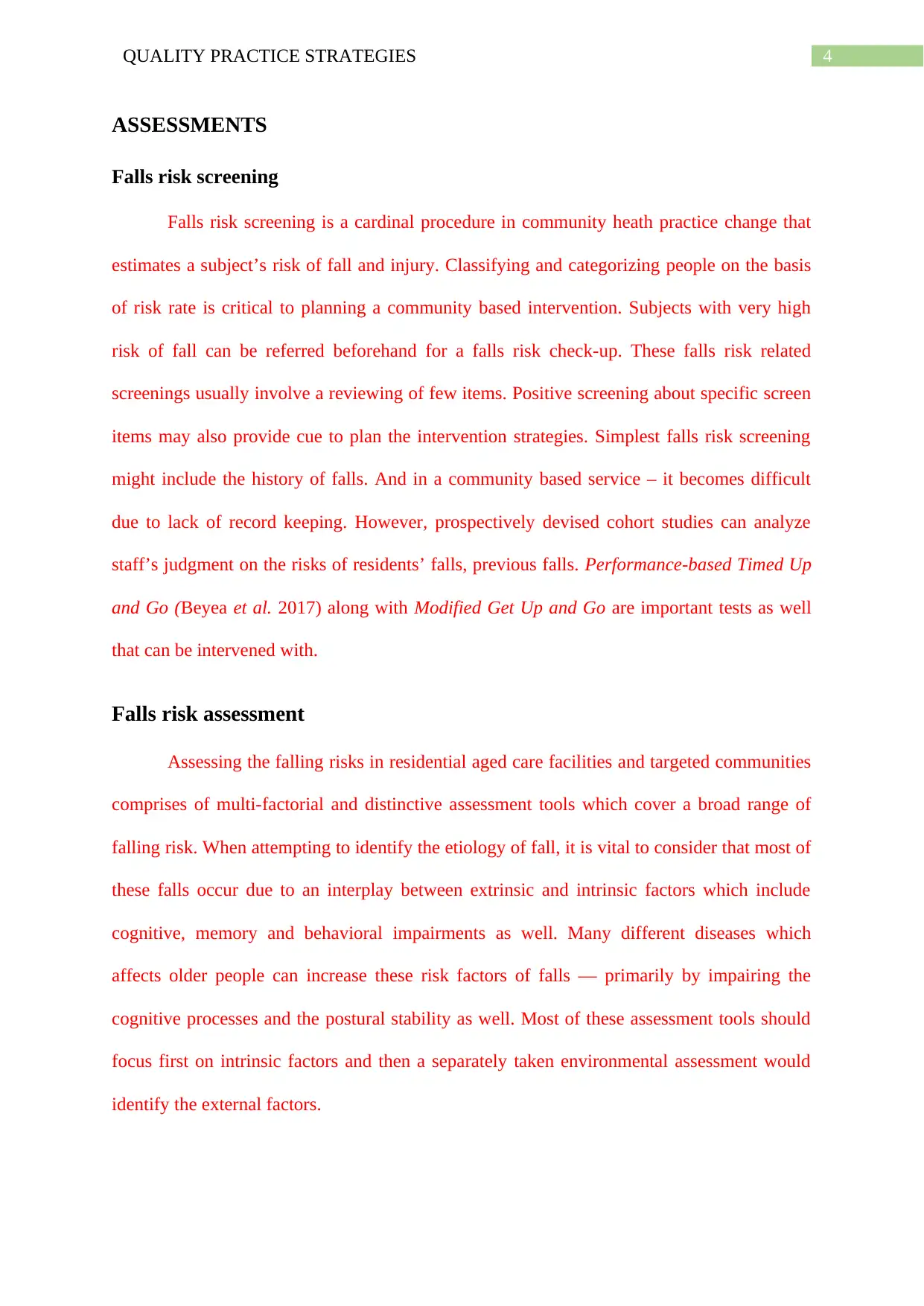
4QUALITY PRACTICE STRATEGIES
ASSESSMENTS
Falls risk screening
Falls risk screening is a cardinal procedure in community heath practice change that
estimates a subject’s risk of fall and injury. Classifying and categorizing people on the basis
of risk rate is critical to planning a community based intervention. Subjects with very high
risk of fall can be referred beforehand for a falls risk check-up. These falls risk related
screenings usually involve a reviewing of few items. Positive screening about specific screen
items may also provide cue to plan the intervention strategies. Simplest falls risk screening
might include the history of falls. And in a community based service – it becomes difficult
due to lack of record keeping. However, prospectively devised cohort studies can analyze
staff’s judgment on the risks of residents’ falls, previous falls. Performance-based Timed Up
and Go (Beyea et al. 2017) along with Modified Get Up and Go are important tests as well
that can be intervened with.
Falls risk assessment
Assessing the falling risks in residential aged care facilities and targeted communities
comprises of multi-factorial and distinctive assessment tools which cover a broad range of
falling risk. When attempting to identify the etiology of fall, it is vital to consider that most of
these falls occur due to an interplay between extrinsic and intrinsic factors which include
cognitive, memory and behavioral impairments as well. Many different diseases which
affects older people can increase these risk factors of falls — primarily by impairing the
cognitive processes and the postural stability as well. Most of these assessment tools should
focus first on intrinsic factors and then a separately taken environmental assessment would
identify the external factors.
ASSESSMENTS
Falls risk screening
Falls risk screening is a cardinal procedure in community heath practice change that
estimates a subject’s risk of fall and injury. Classifying and categorizing people on the basis
of risk rate is critical to planning a community based intervention. Subjects with very high
risk of fall can be referred beforehand for a falls risk check-up. These falls risk related
screenings usually involve a reviewing of few items. Positive screening about specific screen
items may also provide cue to plan the intervention strategies. Simplest falls risk screening
might include the history of falls. And in a community based service – it becomes difficult
due to lack of record keeping. However, prospectively devised cohort studies can analyze
staff’s judgment on the risks of residents’ falls, previous falls. Performance-based Timed Up
and Go (Beyea et al. 2017) along with Modified Get Up and Go are important tests as well
that can be intervened with.
Falls risk assessment
Assessing the falling risks in residential aged care facilities and targeted communities
comprises of multi-factorial and distinctive assessment tools which cover a broad range of
falling risk. When attempting to identify the etiology of fall, it is vital to consider that most of
these falls occur due to an interplay between extrinsic and intrinsic factors which include
cognitive, memory and behavioral impairments as well. Many different diseases which
affects older people can increase these risk factors of falls — primarily by impairing the
cognitive processes and the postural stability as well. Most of these assessment tools should
focus first on intrinsic factors and then a separately taken environmental assessment would
identify the external factors.
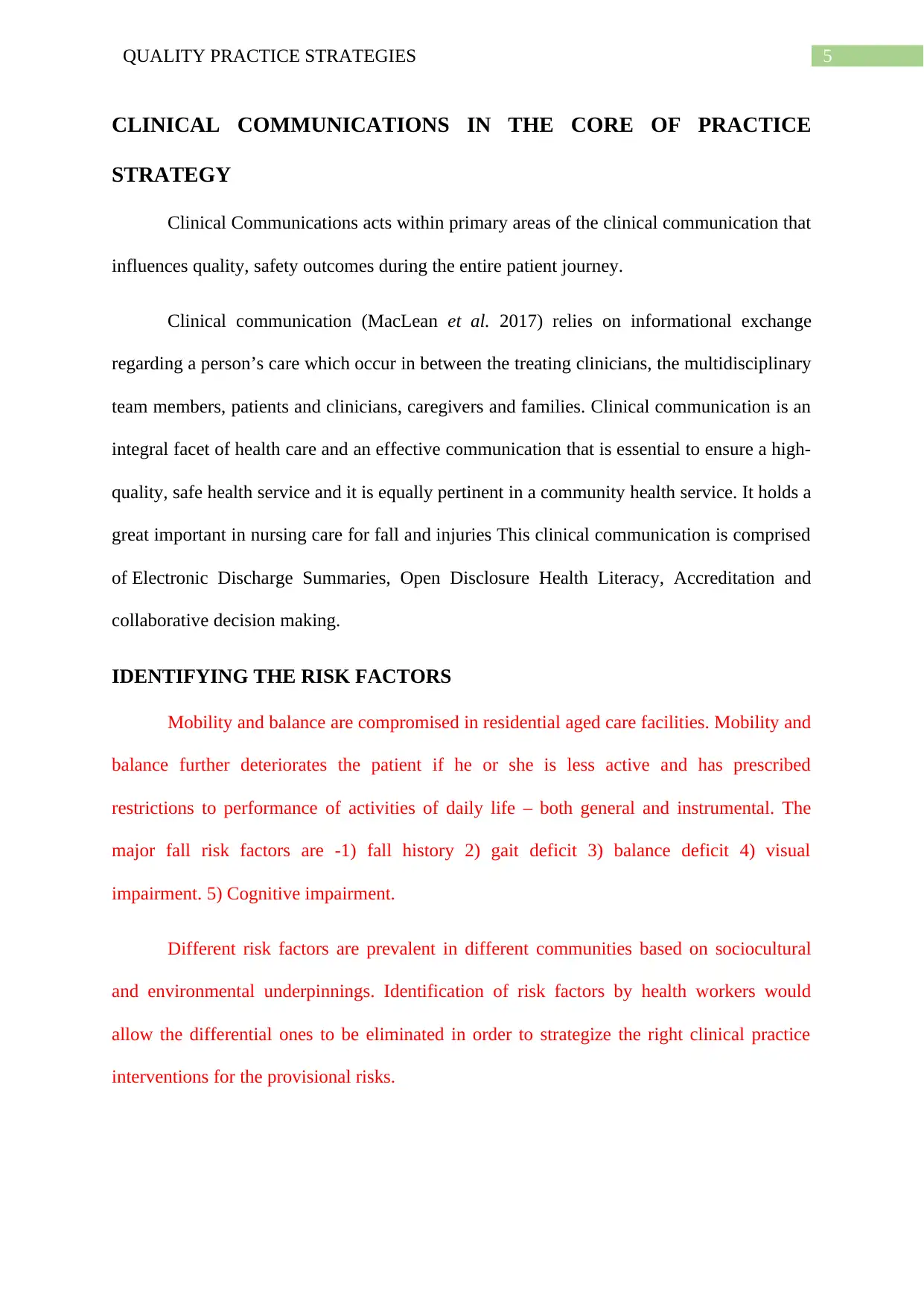
5QUALITY PRACTICE STRATEGIES
CLINICAL COMMUNICATIONS IN THE CORE OF PRACTICE
STRATEGY
Clinical Communications acts within primary areas of the clinical communication that
influences quality, safety outcomes during the entire patient journey.
Clinical communication (MacLean et al. 2017) relies on informational exchange
regarding a person’s care which occur in between the treating clinicians, the multidisciplinary
team members, patients and clinicians, caregivers and families. Clinical communication is an
integral facet of health care and an effective communication that is essential to ensure a high-
quality, safe health service and it is equally pertinent in a community health service. It holds a
great important in nursing care for fall and injuries This clinical communication is comprised
of Electronic Discharge Summaries, Open Disclosure Health Literacy, Accreditation and
collaborative decision making.
IDENTIFYING THE RISK FACTORS
Mobility and balance are compromised in residential aged care facilities. Mobility and
balance further deteriorates the patient if he or she is less active and has prescribed
restrictions to performance of activities of daily life – both general and instrumental. The
major fall risk factors are -1) fall history 2) gait deficit 3) balance deficit 4) visual
impairment. 5) Cognitive impairment.
Different risk factors are prevalent in different communities based on sociocultural
and environmental underpinnings. Identification of risk factors by health workers would
allow the differential ones to be eliminated in order to strategize the right clinical practice
interventions for the provisional risks.
CLINICAL COMMUNICATIONS IN THE CORE OF PRACTICE
STRATEGY
Clinical Communications acts within primary areas of the clinical communication that
influences quality, safety outcomes during the entire patient journey.
Clinical communication (MacLean et al. 2017) relies on informational exchange
regarding a person’s care which occur in between the treating clinicians, the multidisciplinary
team members, patients and clinicians, caregivers and families. Clinical communication is an
integral facet of health care and an effective communication that is essential to ensure a high-
quality, safe health service and it is equally pertinent in a community health service. It holds a
great important in nursing care for fall and injuries This clinical communication is comprised
of Electronic Discharge Summaries, Open Disclosure Health Literacy, Accreditation and
collaborative decision making.
IDENTIFYING THE RISK FACTORS
Mobility and balance are compromised in residential aged care facilities. Mobility and
balance further deteriorates the patient if he or she is less active and has prescribed
restrictions to performance of activities of daily life – both general and instrumental. The
major fall risk factors are -1) fall history 2) gait deficit 3) balance deficit 4) visual
impairment. 5) Cognitive impairment.
Different risk factors are prevalent in different communities based on sociocultural
and environmental underpinnings. Identification of risk factors by health workers would
allow the differential ones to be eliminated in order to strategize the right clinical practice
interventions for the provisional risks.
⊘ This is a preview!⊘
Do you want full access?
Subscribe today to unlock all pages.

Trusted by 1+ million students worldwide
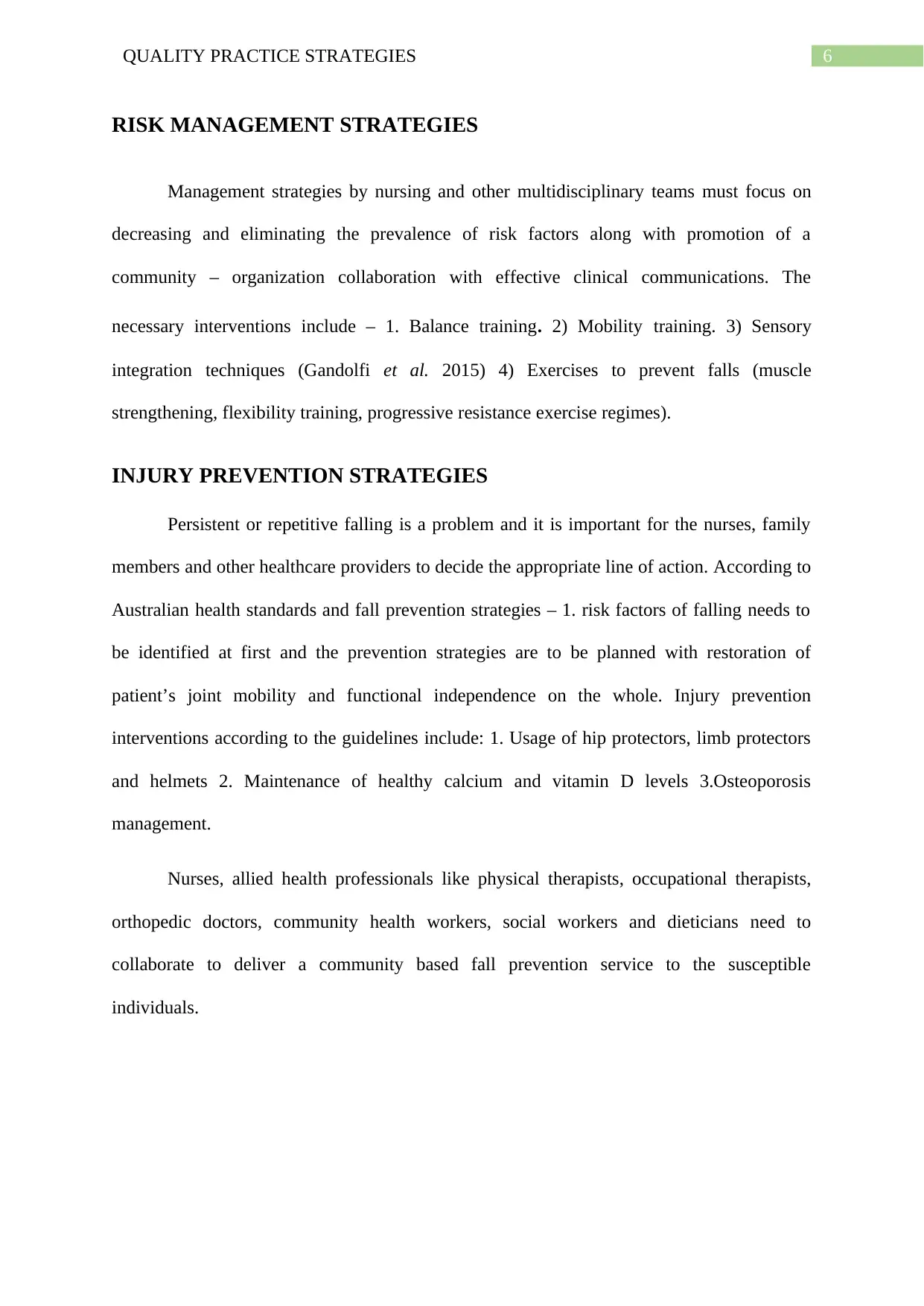
6QUALITY PRACTICE STRATEGIES
RISK MANAGEMENT STRATEGIES
Management strategies by nursing and other multidisciplinary teams must focus on
decreasing and eliminating the prevalence of risk factors along with promotion of a
community – organization collaboration with effective clinical communications. The
necessary interventions include – 1. Balance training. 2) Mobility training. 3) Sensory
integration techniques (Gandolfi et al. 2015) 4) Exercises to prevent falls (muscle
strengthening, flexibility training, progressive resistance exercise regimes).
INJURY PREVENTION STRATEGIES
Persistent or repetitive falling is a problem and it is important for the nurses, family
members and other healthcare providers to decide the appropriate line of action. According to
Australian health standards and fall prevention strategies – 1. risk factors of falling needs to
be identified at first and the prevention strategies are to be planned with restoration of
patient’s joint mobility and functional independence on the whole. Injury prevention
interventions according to the guidelines include: 1. Usage of hip protectors, limb protectors
and helmets 2. Maintenance of healthy calcium and vitamin D levels 3.Osteoporosis
management.
Nurses, allied health professionals like physical therapists, occupational therapists,
orthopedic doctors, community health workers, social workers and dieticians need to
collaborate to deliver a community based fall prevention service to the susceptible
individuals.
RISK MANAGEMENT STRATEGIES
Management strategies by nursing and other multidisciplinary teams must focus on
decreasing and eliminating the prevalence of risk factors along with promotion of a
community – organization collaboration with effective clinical communications. The
necessary interventions include – 1. Balance training. 2) Mobility training. 3) Sensory
integration techniques (Gandolfi et al. 2015) 4) Exercises to prevent falls (muscle
strengthening, flexibility training, progressive resistance exercise regimes).
INJURY PREVENTION STRATEGIES
Persistent or repetitive falling is a problem and it is important for the nurses, family
members and other healthcare providers to decide the appropriate line of action. According to
Australian health standards and fall prevention strategies – 1. risk factors of falling needs to
be identified at first and the prevention strategies are to be planned with restoration of
patient’s joint mobility and functional independence on the whole. Injury prevention
interventions according to the guidelines include: 1. Usage of hip protectors, limb protectors
and helmets 2. Maintenance of healthy calcium and vitamin D levels 3.Osteoporosis
management.
Nurses, allied health professionals like physical therapists, occupational therapists,
orthopedic doctors, community health workers, social workers and dieticians need to
collaborate to deliver a community based fall prevention service to the susceptible
individuals.
Paraphrase This Document
Need a fresh take? Get an instant paraphrase of this document with our AI Paraphraser
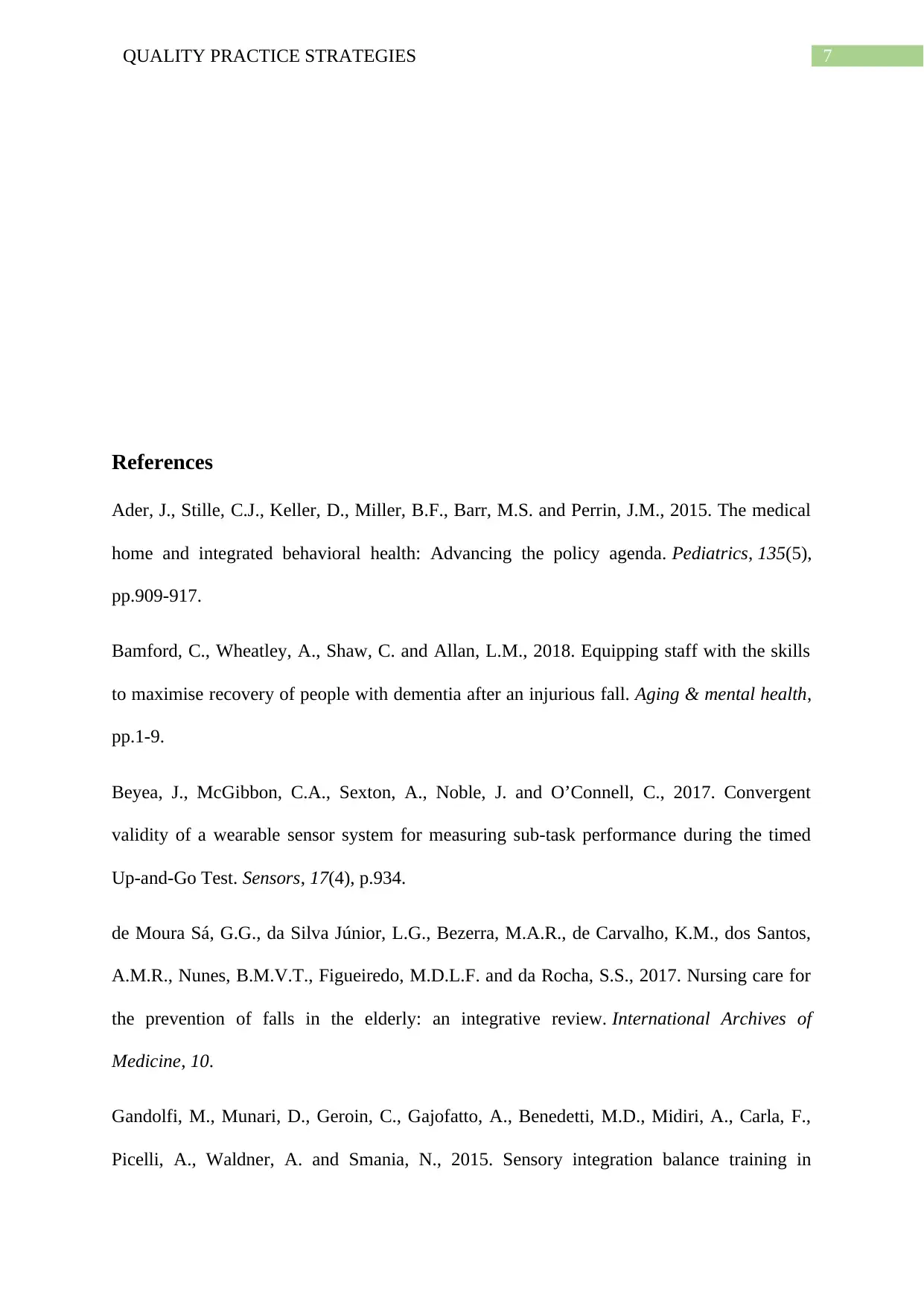
7QUALITY PRACTICE STRATEGIES
References
Ader, J., Stille, C.J., Keller, D., Miller, B.F., Barr, M.S. and Perrin, J.M., 2015. The medical
home and integrated behavioral health: Advancing the policy agenda. Pediatrics, 135(5),
pp.909-917.
Bamford, C., Wheatley, A., Shaw, C. and Allan, L.M., 2018. Equipping staff with the skills
to maximise recovery of people with dementia after an injurious fall. Aging & mental health,
pp.1-9.
Beyea, J., McGibbon, C.A., Sexton, A., Noble, J. and O’Connell, C., 2017. Convergent
validity of a wearable sensor system for measuring sub-task performance during the timed
Up-and-Go Test. Sensors, 17(4), p.934.
de Moura Sá, G.G., da Silva Júnior, L.G., Bezerra, M.A.R., de Carvalho, K.M., dos Santos,
A.M.R., Nunes, B.M.V.T., Figueiredo, M.D.L.F. and da Rocha, S.S., 2017. Nursing care for
the prevention of falls in the elderly: an integrative review. International Archives of
Medicine, 10.
Gandolfi, M., Munari, D., Geroin, C., Gajofatto, A., Benedetti, M.D., Midiri, A., Carla, F.,
Picelli, A., Waldner, A. and Smania, N., 2015. Sensory integration balance training in
References
Ader, J., Stille, C.J., Keller, D., Miller, B.F., Barr, M.S. and Perrin, J.M., 2015. The medical
home and integrated behavioral health: Advancing the policy agenda. Pediatrics, 135(5),
pp.909-917.
Bamford, C., Wheatley, A., Shaw, C. and Allan, L.M., 2018. Equipping staff with the skills
to maximise recovery of people with dementia after an injurious fall. Aging & mental health,
pp.1-9.
Beyea, J., McGibbon, C.A., Sexton, A., Noble, J. and O’Connell, C., 2017. Convergent
validity of a wearable sensor system for measuring sub-task performance during the timed
Up-and-Go Test. Sensors, 17(4), p.934.
de Moura Sá, G.G., da Silva Júnior, L.G., Bezerra, M.A.R., de Carvalho, K.M., dos Santos,
A.M.R., Nunes, B.M.V.T., Figueiredo, M.D.L.F. and da Rocha, S.S., 2017. Nursing care for
the prevention of falls in the elderly: an integrative review. International Archives of
Medicine, 10.
Gandolfi, M., Munari, D., Geroin, C., Gajofatto, A., Benedetti, M.D., Midiri, A., Carla, F.,
Picelli, A., Waldner, A. and Smania, N., 2015. Sensory integration balance training in
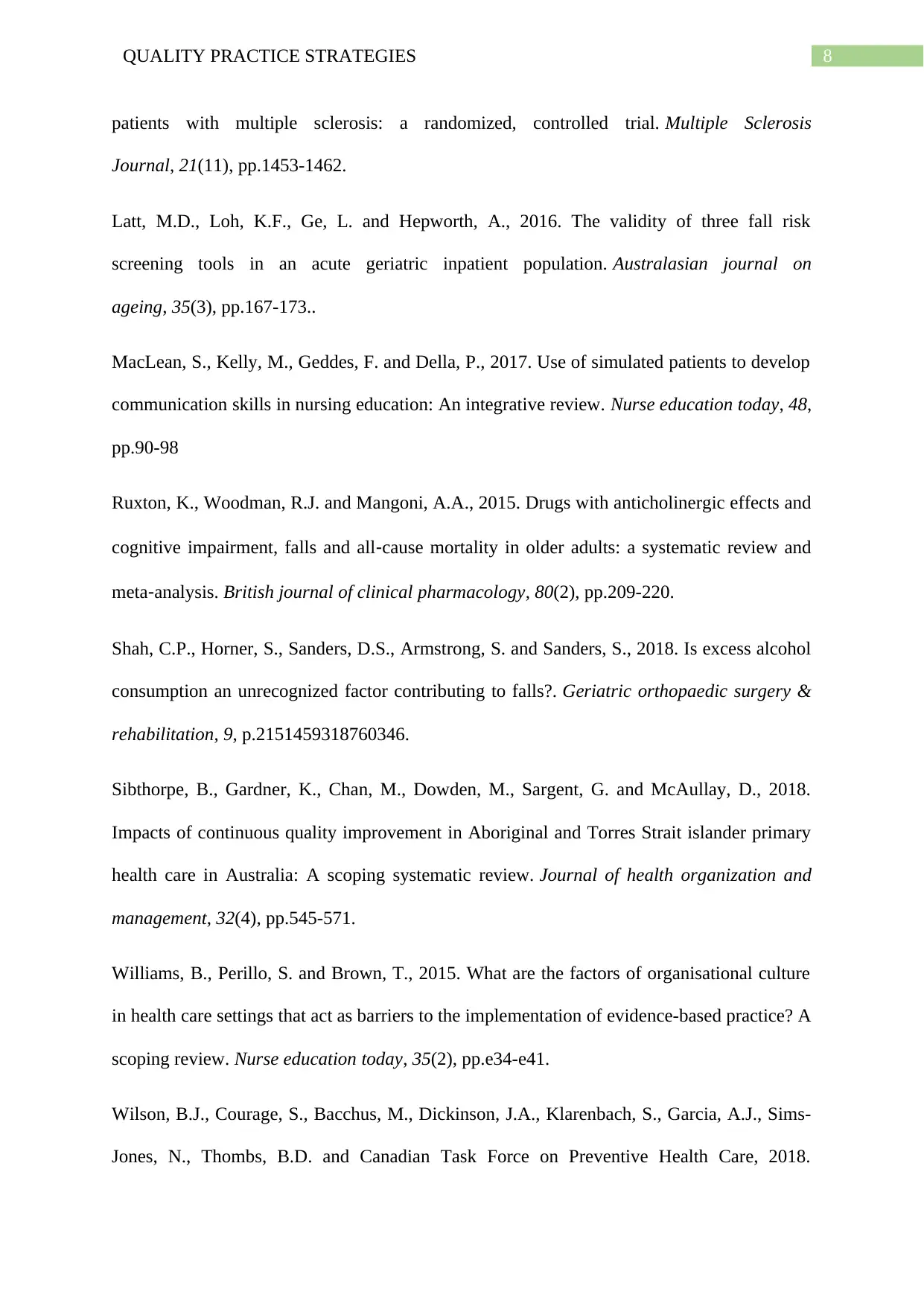
8QUALITY PRACTICE STRATEGIES
patients with multiple sclerosis: a randomized, controlled trial. Multiple Sclerosis
Journal, 21(11), pp.1453-1462.
Latt, M.D., Loh, K.F., Ge, L. and Hepworth, A., 2016. The validity of three fall risk
screening tools in an acute geriatric inpatient population. Australasian journal on
ageing, 35(3), pp.167-173..
MacLean, S., Kelly, M., Geddes, F. and Della, P., 2017. Use of simulated patients to develop
communication skills in nursing education: An integrative review. Nurse education today, 48,
pp.90-98
Ruxton, K., Woodman, R.J. and Mangoni, A.A., 2015. Drugs with anticholinergic effects and
cognitive impairment, falls and all‐cause mortality in older adults: a systematic review and
meta‐analysis. British journal of clinical pharmacology, 80(2), pp.209-220.
Shah, C.P., Horner, S., Sanders, D.S., Armstrong, S. and Sanders, S., 2018. Is excess alcohol
consumption an unrecognized factor contributing to falls?. Geriatric orthopaedic surgery &
rehabilitation, 9, p.2151459318760346.
Sibthorpe, B., Gardner, K., Chan, M., Dowden, M., Sargent, G. and McAullay, D., 2018.
Impacts of continuous quality improvement in Aboriginal and Torres Strait islander primary
health care in Australia: A scoping systematic review. Journal of health organization and
management, 32(4), pp.545-571.
Williams, B., Perillo, S. and Brown, T., 2015. What are the factors of organisational culture
in health care settings that act as barriers to the implementation of evidence-based practice? A
scoping review. Nurse education today, 35(2), pp.e34-e41.
Wilson, B.J., Courage, S., Bacchus, M., Dickinson, J.A., Klarenbach, S., Garcia, A.J., Sims-
Jones, N., Thombs, B.D. and Canadian Task Force on Preventive Health Care, 2018.
patients with multiple sclerosis: a randomized, controlled trial. Multiple Sclerosis
Journal, 21(11), pp.1453-1462.
Latt, M.D., Loh, K.F., Ge, L. and Hepworth, A., 2016. The validity of three fall risk
screening tools in an acute geriatric inpatient population. Australasian journal on
ageing, 35(3), pp.167-173..
MacLean, S., Kelly, M., Geddes, F. and Della, P., 2017. Use of simulated patients to develop
communication skills in nursing education: An integrative review. Nurse education today, 48,
pp.90-98
Ruxton, K., Woodman, R.J. and Mangoni, A.A., 2015. Drugs with anticholinergic effects and
cognitive impairment, falls and all‐cause mortality in older adults: a systematic review and
meta‐analysis. British journal of clinical pharmacology, 80(2), pp.209-220.
Shah, C.P., Horner, S., Sanders, D.S., Armstrong, S. and Sanders, S., 2018. Is excess alcohol
consumption an unrecognized factor contributing to falls?. Geriatric orthopaedic surgery &
rehabilitation, 9, p.2151459318760346.
Sibthorpe, B., Gardner, K., Chan, M., Dowden, M., Sargent, G. and McAullay, D., 2018.
Impacts of continuous quality improvement in Aboriginal and Torres Strait islander primary
health care in Australia: A scoping systematic review. Journal of health organization and
management, 32(4), pp.545-571.
Williams, B., Perillo, S. and Brown, T., 2015. What are the factors of organisational culture
in health care settings that act as barriers to the implementation of evidence-based practice? A
scoping review. Nurse education today, 35(2), pp.e34-e41.
Wilson, B.J., Courage, S., Bacchus, M., Dickinson, J.A., Klarenbach, S., Garcia, A.J., Sims-
Jones, N., Thombs, B.D. and Canadian Task Force on Preventive Health Care, 2018.
⊘ This is a preview!⊘
Do you want full access?
Subscribe today to unlock all pages.

Trusted by 1+ million students worldwide
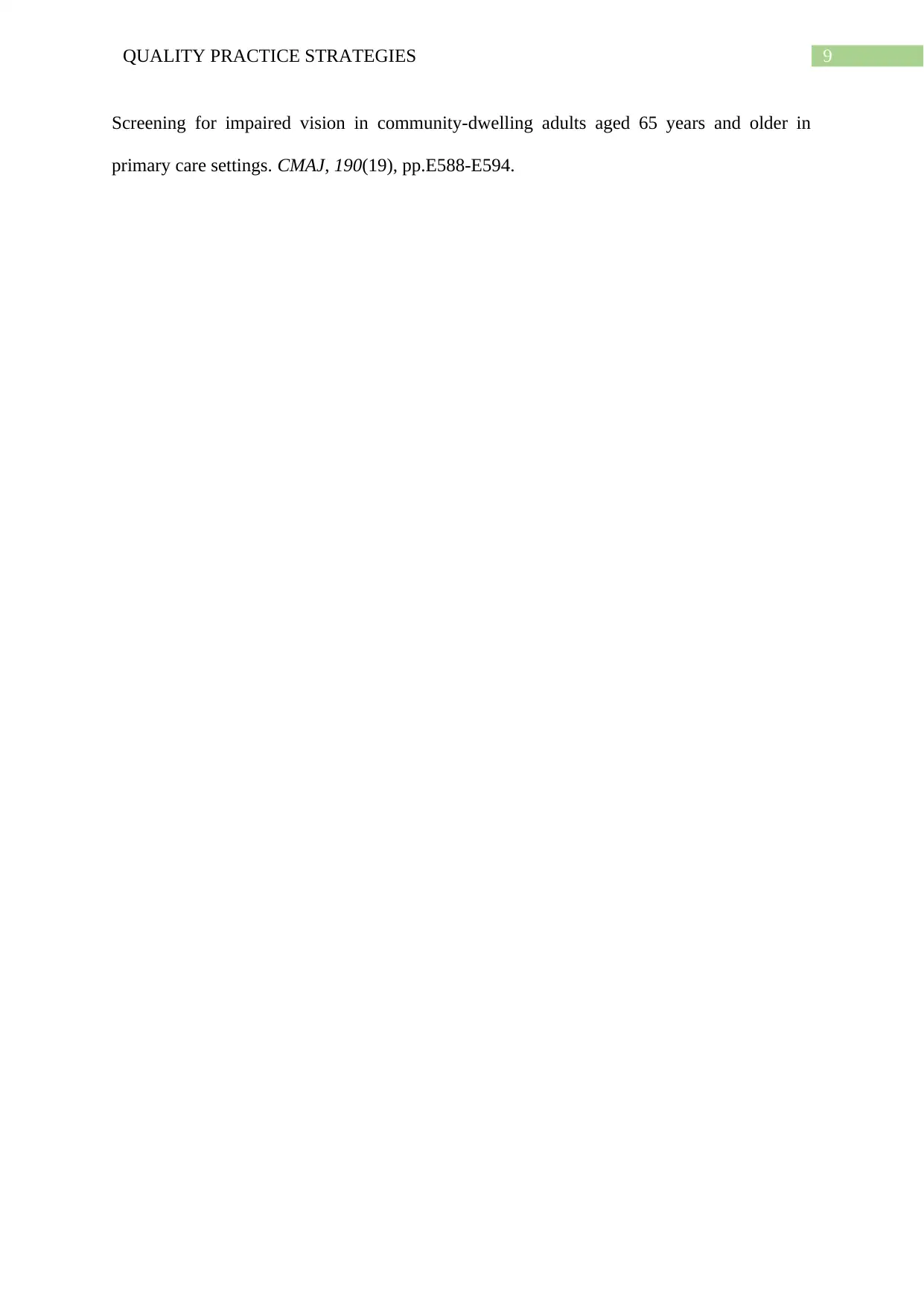
9QUALITY PRACTICE STRATEGIES
Screening for impaired vision in community-dwelling adults aged 65 years and older in
primary care settings. CMAJ, 190(19), pp.E588-E594.
Screening for impaired vision in community-dwelling adults aged 65 years and older in
primary care settings. CMAJ, 190(19), pp.E588-E594.
1 out of 10
Related Documents
Your All-in-One AI-Powered Toolkit for Academic Success.
+13062052269
info@desklib.com
Available 24*7 on WhatsApp / Email
![[object Object]](/_next/static/media/star-bottom.7253800d.svg)
Unlock your academic potential
Copyright © 2020–2025 A2Z Services. All Rights Reserved. Developed and managed by ZUCOL.





